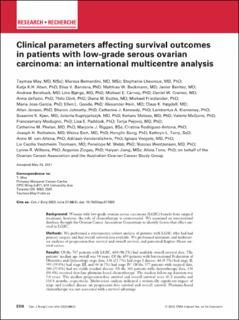Clinical parameters affecting survival outcomes in patients with low-grade serous ovarian carcinoma: An international multicentre analysis
May, Taymaa; Bernardini, Marcus; Lheureux, Stephanie; Aben, Katja K.H.; Bandera, Elisa V.; Beckmann, Matthias W.; Benitez, Javier; Berchuck, Andrew; Bjørge, Line; Carney, Michael E.; Cramer, Daniel W.; Defazio, Anna; Dörk, Thilo; Eccles, Diana M.; Friedlander, Michael; García, María Jose; Goode, Ellen L.; Hein, Alexander; Jensen, Allan; Johnatty, Sharon; Kennedy, Catherine J.; Kiemeney, Lambertus A.; Kjær, Susanne K.; Kupryjanczyk, Jolanta; Matsuo, Keitaro; McGuire, Valerie; Modugno, Francesmary; Paddock, Lisa E.; Pejovic, Tanja; Phelan, Catherine M.; Riggan, Marjorie J.; Rodriguez-Antona, Cristina; Rothstein, Joseph H.; Sieh, Weiva; Song, Honglin; Terry, Kathryn L.; Altena, Anne M. Van; Vanderstichele, Adriaan; Vergote, Ignace; Thomsen, Liv Cecilie Vestrheim; Webb, Penelope M.; Wentzensen, Nicolas; Wilkens, Lynne R.; Ziogas, Argyrios; Jiang, Haiyan; Tone, Alicia
Journal article, Peer reviewed
Published version

Åpne
Permanent lenke
https://hdl.handle.net/11250/3095395Utgivelsesdato
2023Metadata
Vis full innførselSamlinger
- Department of Clinical Science [2318]
- Registrations from Cristin [9791]
Originalversjon
CMAJ - Canadian Medical Association Journal. 2023, 66 (3), E310-E320. 10.1503/cjs.017020Sammendrag
Background: Women with low-grade ovarian serous carcinoma (LGSC) benefit from surgical treatment; however, the role of chemotherapy is controversial. We examined an international database through the Ovarian Cancer Association Consortium to identify factors that affect survival in LGSC.
Methods: We performed a retrospective cohort analysis of patients with LGSC who had had primary surgery and had overall survival data available. We performed univariate and multivariate analyses of progression-free survival and overall survival, and generated Kaplan–Meier survival curves.
Results: Of the 707 patients with LGSC, 680 (96.2%) had available overall survival data. The patients’ median age overall was 54 years. Of the 659 patients with International Federation of Obstetrics and Gynecology stage data, 156 (23.7%) had stage I disease, 64 (9.7%) had stage II, 395 (59.9%) had stage III, and 44 (6.7%) had stage IV. Of the 377 patients with surgical data, 200 (53.0%) had no visible residual disease. Of the 361 patients with chemotherapy data, 330 (91.4%) received first-line platinum-based chemotherapy. The median follow-up duration was 5.0 years. The median progression-free survival and overall survival were 43.2 months and 110.4 months, respectively. Multivariate analysis indicated a statistically significant impact of stage and residual disease on progression-free survival and overall survival. Platinum-based chemotherapy was not associated with a survival advantage.
Conclusion: This multicentre analysis indicates that complete surgical cytoreduction to no visible residual disease has the most impact on improved survival in LGSC. This finding could immediately inform and change practice.
